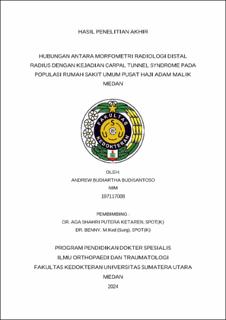Hubungan Antara Morfometri Radiologi Distal Radius dengan Kejadian Carpal Tunnel Syndrome pada Populasi Rumah Sakit Umum Pusat Haji Adam Malik Medan
Correlation of The Distal Radius Morphometry with Carpal Tunnel Syndrome in Adam Malik General Hospital

Date
2024Author
Budisantoso, Andrew Budiartha
Advisor(s)
Ketaren, Aga Shahri Putera
Benny
Metadata
Show full item recordAbstract
Backgrounds Carpal tunnel syndrome (CTS) is one of the most common peripheral neuropathies that can produce significant comorbidities. Current evidence showed that morphometry of the distal radius can alter the biomechanical and kinematics of the wrist joint, which can be a factor that influences the development of CTS.
Methods This is a analytic case control study of 55 patients. We measure the radiographic parameters of the wrists on posteroanterior and lateral view such as radial height, radial inclination, ulnar variance, radiocarpal interval, volar tilt, and AP distance and comparing it between carpal tunnel syndrome patients and healthy patients as controls. The morphometry of the distal radius, including, was measured from plain x-ray.
Results
The mean measurement results were as follows: radial height (mm) 10.71 ± 2.37 in CTS group and 11.50 ± 1.97 in normal control; Radial Inclination (°) 24.34 ± 3.23 and 25.32 ± 2.98; Ulnar Variance 1.19 mm ± 0.88 and 0.19 mm ± 1.15, Radiocarpal Interval 2.13 ± 0.64 and 2.25 ± 0.56, Volar Tilt (°) 9.10 ± 6.32 and 8.90 ± 6.75, AP Distance (mm) 15.81 ± 3.23 and 15.89 ± 3.3. The ulnar variance was significantly larger in the CTS patients compared to the controls for the patients and control. Conclusion
Distal radius morphology will affect the biomechanic and kinematics of the wrist joint, where those changes might result in the development of various pathological conditions of the wrist, one of which is CTS. We found that ulnar variance is a significant factor affecting the development of CTS. That is why we suggest that special care should be given to the ulnar variance in patient presenting with symptoms in the wrist region, whenever it is available.
Collections
- Master Theses [72]
